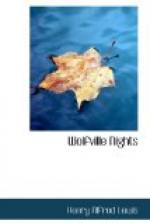There are certain truths of a botanical character that are not generally known. Each year the trees in their occupation creep further west. There are regions in Missouri—not bottom lands—which sixty years ago were bald and bare of trees. Today they are heavy with timber. Westward, beyond the trees, lie the prairies, and beyond the prairies, the plains; the first are green with long grasses, the latter bare, brown and with a crisp, scorched, sparse vesture of vegetation scarce worth the name. As the trees march slowly westward in conquest of the prairies, so also do the prairies, in their verdant turn, become aggressors and push westward upon the plains. These last stretches, extending to the base of that bluff and sudden bulwark, the Rocky Mountains, can go no further. The Rockies hold the plains at bay and break, as it were, the teeth of the desert. As a result of this warfare of vegetations, the plains are to first disappear in favour of the prairies; and the prairies to give way before the trees. These mutations all wait on rain; and as the rain belt goes ever and ever westward, a strip of plains each year surrenders its aridity, and the prairies and then the trees press on and take new ground.
These facts should contain some virtue of interest; the more since with the changes chronicled, come also changes in the character of both the inhabitants and the employments of these regions. With a civilised people extending themselves over new lands, cattle form ever the advance guard. Then come the farms. This is the procession of a civilised, peaceful invasion; thus is the column marshalled. First, the pastoral; next, the agricultural; third and last, the manufacturing;—and per consequence, the big cities, where the treasure chests of a race are kept. Blood and bone and muscle and heart are to the front; and the money that steadies and stays and protects and repays them and their efforts, to the rear.
Forty years ago about all that took place west of the Mississipi of a money-making character was born of cattle. The cattle were worked in huge herds and, like the buffalo supplanted by them, roamed in unnumbered thousands. In a pre-railroad period, cattle were killed for their hides and tallow, and smart Yankee coasters went constantly to such ports as Galveston for these cargoes. The beef was left to the coyotes.
Cattle find a natural theatre of existence on the plains. There, likewise, flourishes the pastoral man. But cattle herding, confined to the plains, gives way before the westward creep of agriculture. Each year beholds more western acres broken by the plough; each year witnesses a diminution of the cattle ranges and cattle herding. This need ring no bell of alarm concerning a future barren of a beef supply. More cattle are the product of the farm-regions than of the ranges. That ground, once range and now farm, raises more cattle now than then. Texas is a great cattle State. Ohio, Indiana, Illinois, Iowa, and Missouri are first States of agriculture. The area of Texas is about even with the collected area of the other five. Yet one finds double the number of cattle in Ohio, Indiana, Illinois, Iowa, and Missouri than in Texas, to say nothing of tenfold the sheep and hogs. No; one may be calm; one is not to fall a prey to any hunger of beef.




